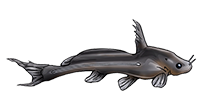L25 activity (or lack of)
L25 activity (or lack of)
I acquired a 4" l25 2 weeks ago and am still waiting to see it move. I know it eats because I've seen the pile of feces next to it in the morning. How long do they usually have to be in a new environment before they feel comfortable enough to forage around before lights out? Thanks
Steve
Steve
-
Bristle nose
- Posts: 36
- Joined: 12 Jul 2006, 12:30
- My images: 3
- My cats species list: 11 (i:0, k:0)
- Spotted: 2
- Location 1: Wollongong, N.S.W., Australia
- Interests: Breeding and collecting Pleco's, diving, fishing, football, keeping bird's, riding motorbike's, surfing.
I have one that's 8 inches long and I've had him for almost a year. He comes out only when he perceives all is perfectly quiet and at night. I've actually sat in my office for hours and noticed him scurrying about here and there but the instant I move in the room or my wife comes near the room, he bolts under his cave.
I have some 5" L254's in there with him and they seem more agressive than he is but he does defend his territory if they come up there. Mine gets blood worms, frozen krill and the like twice per week and flake/pellet the rest of the time.
I wouldn't worry too much unless he starts to look like he's not eating.
I have some 5" L254's in there with him and they seem more agressive than he is but he does defend his territory if they come up there. Mine gets blood worms, frozen krill and the like twice per week and flake/pellet the rest of the time.
I wouldn't worry too much unless he starts to look like he's not eating.
- mrwickedweasel
- Posts: 23
- Joined: 02 Aug 2006, 20:37
- My images: 8
- My cats species list: 19 (i:0, k:0)
- Spotted: 6
- Location 1: England
- Location 2: Crawley
Hi steve1088, i currentley have 2 L25 in a 110 gallon tank. One is 14 inches long and the other is 6 inches. Both are quite shy and inactive. The 14 inch L25 does adventure out during the day sometimes, but will hide back in her pipe at the first sign of movement from outside the tank. However when there is food in the tank, she is first out to eat and is then a lot more bold. The smaller L25 is completely different. Never ever comes out, ive never seen her eat either. Infact the only time ive seen this one out, was when it was fighting with my black scarlet L320, they where lip locked, fighting across the back of the tank. Fortunatley i can see straight into her cave, and can check belly with out chasing her out and up setting her.
So in short, each L25 is different. Dont worry too much if you dont see it eating that often, and if possible, keep an eye on it belly. Im sure its doing fine
So in short, each L25 is different. Dont worry too much if you dont see it eating that often, and if possible, keep an eye on it belly. Im sure its doing fine




